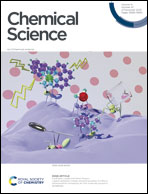Data science enabled discovery of a highly soluble 2,2′-bipyrimidine anolyte for application in a flow battery†
Abstract
Development of non-aqueous redox flow batteries as a viable energy storage solution relies upon the identification of soluble charge carriers capable of storing large amounts of energy over extended time periods. A combination of metrics including number of electrons stored per molecule, redox potential, stability, and solubility of the charge carrier impact performance. In this context, we recently reported a 2,2′-bipyrimidine charge carrier that stores two electrons per molecule with reduction near −2.0 V vs. Fc/Fc+ and high stability. However, these first-generation derivatives showed a modest solubility of 0.17 M (0.34 M e−). Seeking to improve solubility without sacrificing stability, we harnessed the synthetic modularity of this scaffold to design a library of sixteen candidates. Using computed molecular descriptors and a single node decision tree, we found that minimization of the solvent accessible surface area (SASA) can be used to predict derivatives with enhanced solubility. This parameter was used in combination with a heatmap describing stability to de-risk a virtual screen that ultimately identified a 2,2′-bipyrimidine with significantly increased solubility and good stability metrics in the reduced states. This molecule was paired with a cyclopropenium catholyte in a prototype all-organic redox flow battery, achieving a cell potential up to 3 V.

- This article is part of the themed collections: Most popular 2023 energy & environmental chemistry articles, 2023 Chemical Science HOT Article Collection and 2023 ChemSci Pick of the Week Collection


 Please wait while we load your content...
Please wait while we load your content...